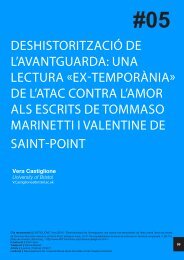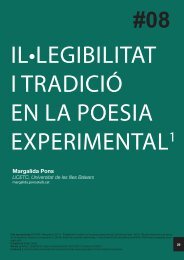03 - 452ºF
03 - 452ºF
03 - 452ºF
You also want an ePaper? Increase the reach of your titles
YUMPU automatically turns print PDFs into web optimized ePapers that Google loves.
meaning, or what he calls «non-reception.» He describes this as<br />
«the strategy of the masses» which, he explains, «is equivalent<br />
to returning to the system its own logic by doubling it, to reflecting<br />
meaning, like a mirror, without absorbing it» (Baudrillard, 1988: 59).<br />
Baudrillard argues that privatizing individuals is the main function of<br />
the media, and this happens through making the recipients live in the<br />
simulacrum, especially that of TV. In this way, they have no choice<br />
but to refuse meaning and accept the images as mere signifiers. This<br />
means that meaning is absorbed and devoured by the media, or it is<br />
«imploded» by the media. This idea of «the implosion» of meaning<br />
and the social in the media was first proposed by Canadian theorist,<br />
Marshall McLuhan. In his book The Medium is the Message (1967),<br />
McLuhan believes that the media are not a source of socializing in<br />
which we have interaction between the medium and the subject; on<br />
the other hand, the message is imploded in the medium. Accordingly,<br />
all contents of meaning are absorbed in the medium, and only the<br />
medium or the form is what matters regardless of the content. In this<br />
way the medium becomes the message.<br />
Like Baudrillard and McLuhan, DeLillo believes that TV is the medium<br />
and the message, and that is due to the process of simulating images<br />
from models and codes that refer to nothing in real life. Murray<br />
Siskind takes TV as a fetishistic object; he tells Jack how his life<br />
changes when this device enters it, «I’ve been sitting in this room for<br />
more than two months, watching TV into the early hours, listening,<br />
taking notes» (DeLillo, 1985: 50-51). Murray doesn’t deny that TV<br />
is a hyperreal simulation, and that it doesn’t go beyond the picture<br />
pattern of its screen. Though he describes the experience as «Close<br />
to mystical,» he knows, deep inside, that it is, «sealed-off, timeless,<br />
self-contained, (and) self-referring» (DeLillo, 1985: 51).<br />
What is more striking, as it is clearly described in White Noise, is<br />
that TV transforms death and catastrophes into spectacles. People<br />
watch scenes of horror and devastation and feel excited and thrilled<br />
by them. The Gladneys gather around the TV set to watch<br />
disasters, and they excitedly call out for each other to come and<br />
watch. They watch plane crashes and volcanic destructions, and<br />
they feel intrigued. Jack once questions the «ecstasy» people feel<br />
when watching disasters transmitted on TV; he wonders «Why is it,<br />
that decent, well-meaning, and responsible people find themselves<br />
intrigued by a catastrophe when they see it on TV?» (DeLillo, 1985:<br />
65). DeLillo describes this feeling as natural and he ascribes it to the<br />
viewers’ desire for a break-up with «the incessant bombardment of<br />
information» (DeLillo, 1985: 66).<br />
It is worth mentioning here that the narrative style of the novel is,<br />
in one way or another, similar to the narrative of TV. Like TV, the<br />
novel provides an influx of information, especially those contained<br />
Living in a simulacrum: how TV and the supermarket redefines reality in Don DeLillo’s White noise - Ahmad Ghashmari<br />
<strong>452ºF</strong>. #<strong>03</strong> (2010) 172-186.<br />
174










